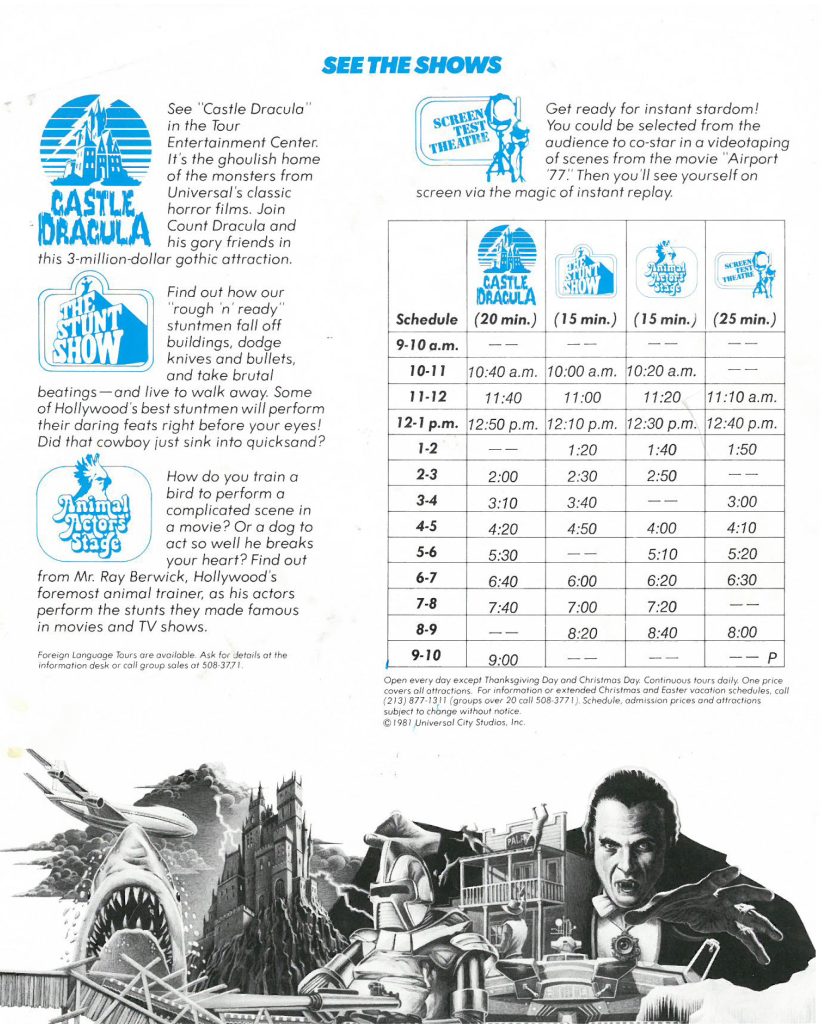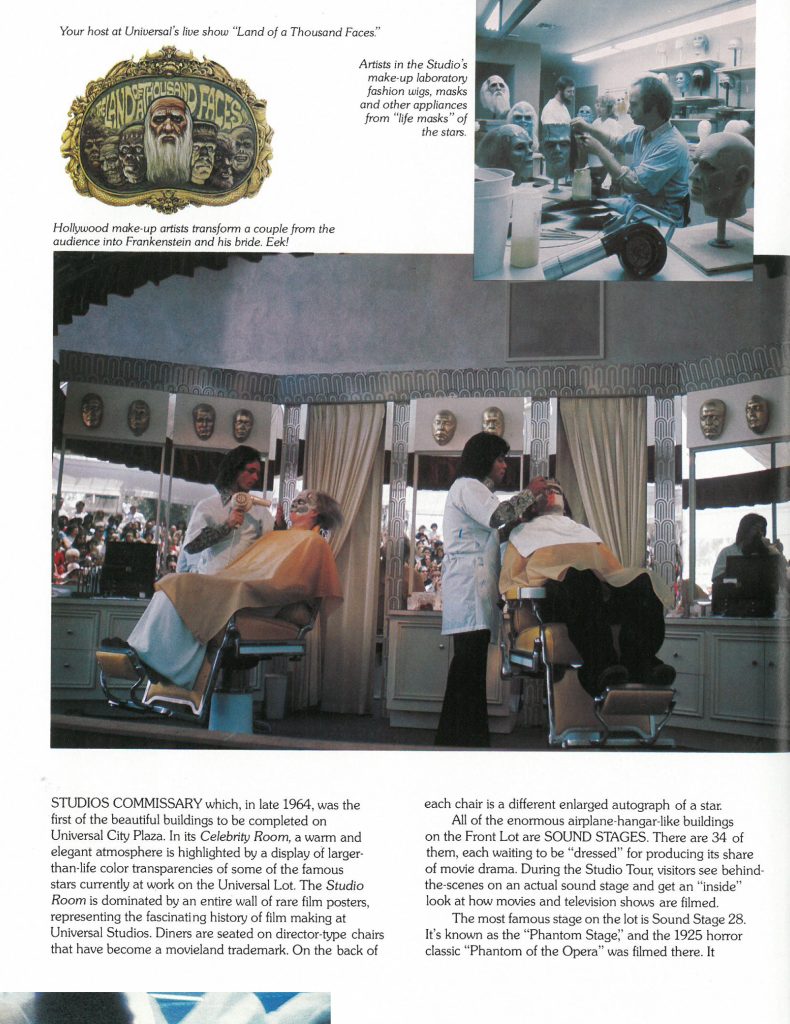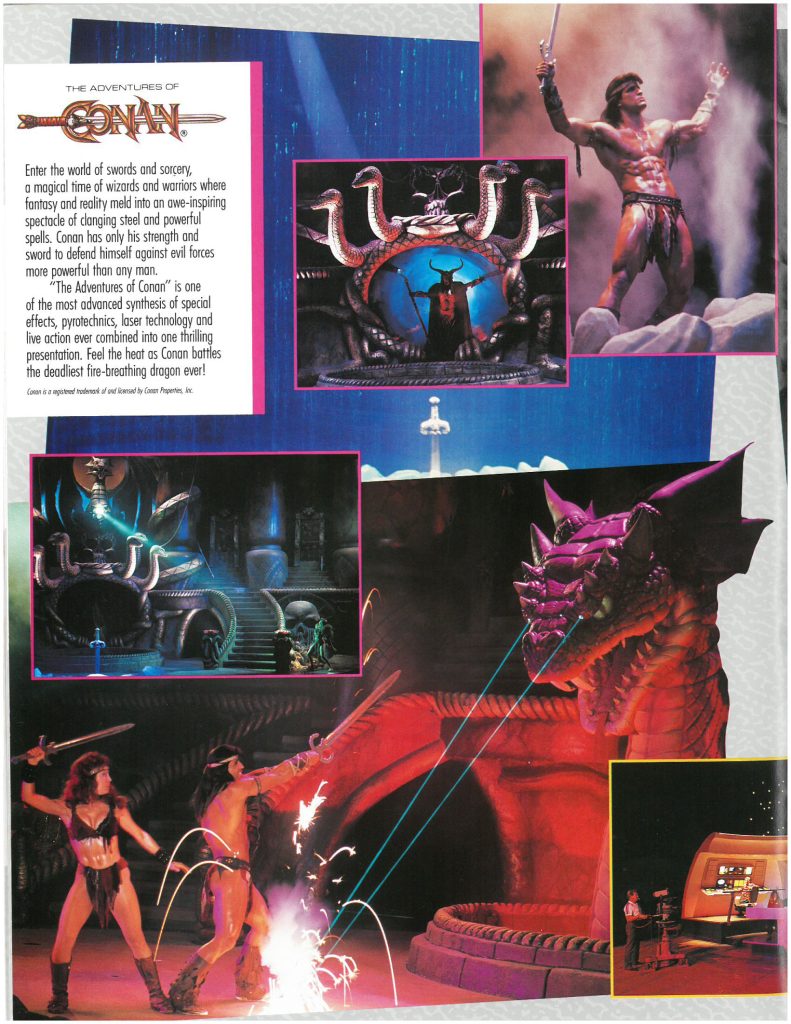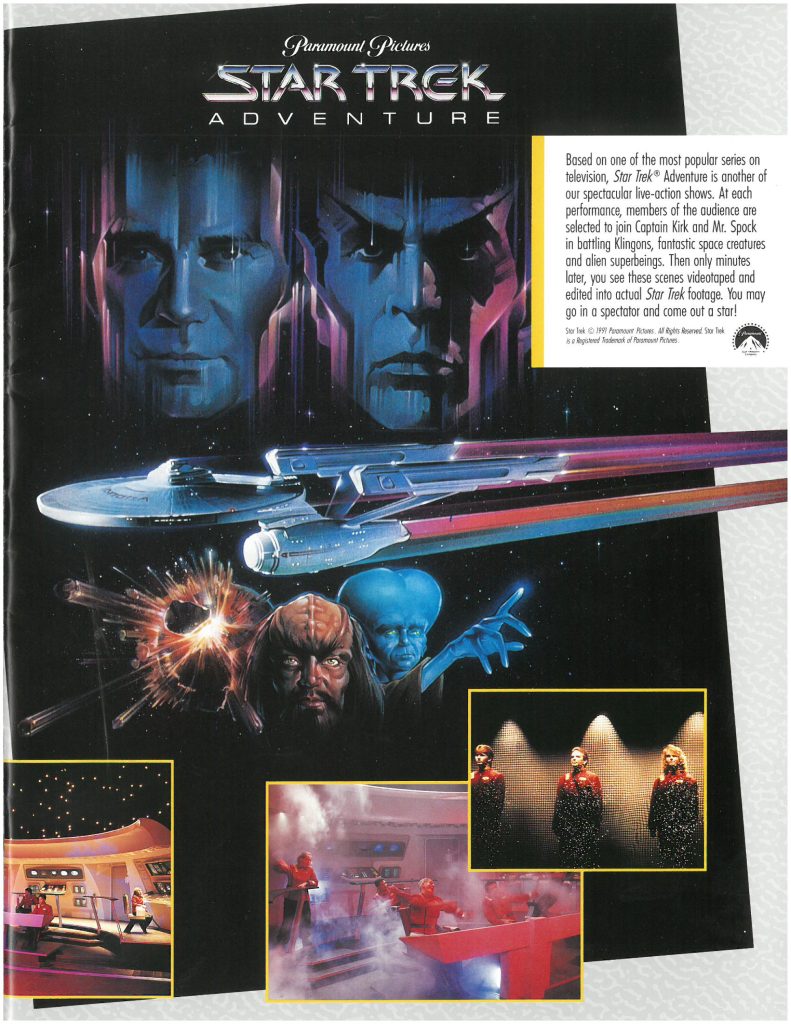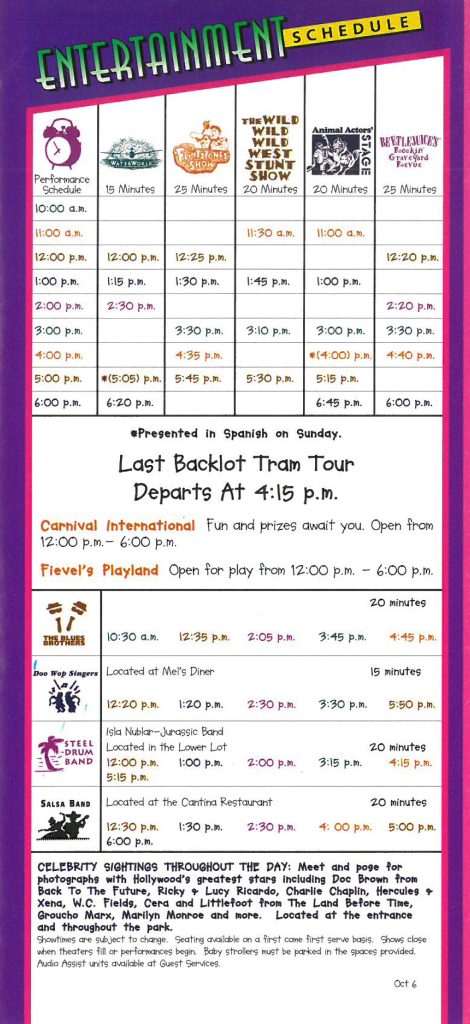People often ask me what I love the most about theme parks. Is it the rides? The food? The shows? The characters?
My answer? Entertainment.
Whether it’s a piano player performing in a small area for just a handful of people, a song and dance show, or even a large-scale show like WaterWorld, I love entertainment in all forms.
Universal Studios Hollywood used to offer something for guests who didn’t want to just stand in 60-to-90-minute lines for a three-minute ride experience. Part of the excitement with entertainment was turning the corner not knowing what you might come upon. These organic experiences – to suddenly hear Sebastian the piano player on Baker Street playing classic 40s songs on the piano or being able to grab a soda and snack, sit down and enjoy live music – can be relaxing and cathartic.
For those who like shows on a much grander scale, you can opt to see one of the most popular shows in theme park history, WaterWorld, and get twenty minutes of a non-stop stunt extravaganza with high falls, plane crashes, and fire explosions.
Being able to get off your feet for an extended period can re-energize your day. For Universal, these shows can lengthen a guest’s stay in the park, improving the potential for additional food or merchandise sales. While not every show has to be grand to the same extent as WaterWorld, some should leave you with a sense of amazement. You want to leave the show feeling truly inspired or at least removed from the real world just for a few moments. Escapism can be a wonderful thing; and while Universal has heavily invested in bringing world-class attractions to Universal Studios Hollywood over the last decade, it also seems that the Entertainment offerings have decreased along with it.
Universal Studios Hollywood has been welcoming guests onto its property since 1964. For the majority of that time, Universal has offered some of the best and most innovative live theme park entertainment in the world. This originates with the creation of the Studio Tour as a way for guests to get a behind-the-scenes look at a working movie and television studio. Universal took regular guests and gave them unprecedented access to how movies and television shows were made. Shortly after the Studio Tour opened in 1964, Jay Stein and Lew Wasserman saw the hit they had on their hands and understood the importance of growing and continuing the concept of showcasing the studio in new ways unmatched by their entertainment peers.
To start, Universal introduced its first two live shows: The Universal Studios Animal Actors Training Stage and The Stunt Show. The Animal Show employed industry-leading Hollywood movie animal trainer Ray Berwick to provide audiences with a glimpse on how animals were trained to perform in film and television. Meanwhile, The Stunt Show gave guests a look at how some of the most famous Western fight scenes were choreographed by Hollywood’s top stunt performers. By today’s standards, both shows would seem rather simple and pedestrian to most modern-day guests. However, during this era, these shows provided access that wowed audiences with never-before-seen insight into movie-making magic.
By the end of 1968, Universal had welcomed more than 3,000,000 guests to its new park. With the expansion of the Visitors Entertainment Center, more entertainment options started to appear with the introduction of character meet and greets, such as Frankenstein, the Phantom of the Opera, – and everyone’s favorite – Baby Frankenstein.
With the success of the Studio Tour and their two new shows, Universal pioneered a new type of show that allowed guests to be placed directly into some of the most popular movies and television shows of the era. With new shows based on television franchises like Adam 12 and Emergency and films such as Airport ’77, these new audience participation shows allowed guests to dress up like Martin Milner, Randolph Mantooth, and Jack Lemmon to recreate memorable scenes; and to truly make guests feel like they participated in something special, at the end of each show they were able to see themselves on television screens placed around the theater at the conclusion of the show.
Jay Stein was never comfortable with anything being subpar and always wanted the best offerings possible. With pressure from management, Universal continued to push the envelope with entertainment in the 70s, with shows like the Land of a Thousand Faces, Screen Test Comedy Theater, and a brand-new concert venue located adjacent to the theme park known as the Universal Amphitheatre.
In 1983, Universal debuted the most technologically advanced show ever created at the time: The Adventures of Conan: A Sword and Sorcery Spectacular. From the moment guests walked into the Castle Theater which had been transformed into an enclosed venue, they would be wowed by a rain curtain that surrounded the entire stage. Once the show began, it became a non-stop experience that included sword fights, indoor explosions, lasers, and a finale that included an animatronic fire-breathing dragon. This show truly had it all. As a technical marvel, Conan entertained audiences for ten years. During this era, Universal offered five large-scale shows.
In 1987, Universal followed up with the ground-breaking Miami Vice Action Spectacular. The year after, Universal introduced their most advanced show: The Star Trek Adventure. The Star Trek Adventure replaced The Screen Test Comedy Theater in the newly built Panasonic Theater (where the DreamWorks Theater currently sits). Star Trek pushed the limits of what could be done in front of a live audience. Audience members were chosen to re-enact scenes aboard the Starship Enterprise and a Klingon Vessel. A particularly memorable segment had four participants beam up right in front of the audience. It was a showstopper that garnered applause at every single show.
In 1991 and 1993, Universal Studios Hollywood added the E.T. Adventure and Back to the Future: The Ride – Their first two stand-alone rides. Even with these additions, Universal was unrestrained in its focus on adding new entertainment.
In between the E.T. Adventure and Back to the Future: The Ride, Universal opened Backdraft in July 1992. Based on the film of the same name, Backdraft was a first-of-its-kind attraction that placed guests in the middle of the climactic chemical warehouse fire scene from the film. Guests would stand on elevated platforms while explosions of fire would engulf the stage just a few feet ahead. The show and formula were a crowd pleaser, spawning a copy at Universal Studios Japan and a new generation of special effects experiences, including Twister at Universal Studios Florida and Lights, Camera, Action at Universal Studios Singapore and Universal Studios Beijing.
To help celebrate their 30th anniversary in 1994 Universal used the Miami Vice show venue to create a new nighttime spectacular known as Spectrablast. Following Miami Vice’s last show of the day, Universal would completely redress the set to accommodate incredible projections, lasers, and fireworks.
in 1995, Universal debuted its most impressive show with the introduction of WaterWorld, which – to this day – stands as one of the highest-rated attractions at the park. The show garnered so much popularity that it spawned copies in Singapore, Japan, and most recently Beijing.
Throughout the 80s and 90s, Universal continued to push the boundaries with shows like An American Tale, Beetlejuice Rockin Graveyard Revue, Totally Nickelodeon, and World of Cinemagic, in addition to smaller scale shows like the Blues Brothers Revue, the Doo Wop Singers, Alvin and the Chipmunks and Rocky and Bullwinkle.
In 1999, Universal took another leap in creating a seasonal event for Christmas called Grinchmas. Over the next decade, Grinchmas grew in scale to house a snow play area and an evening tree lighting which would include a celebrity narrator to read “How the Grinch Stole Christmas’ – along with a fourteen-minute song and dance show with an eleven-person cast. In later iterations, the event featured smaller shows like Martha May singing a few songs and the Who-liday Singers.
A few years later, Universal debuted an all-new Christmas parade called 12 Days of Christmas in 2003, which featured twelve floats. While the floats weren’t as large as the floats found in Anaheim, this development was still a sign of Universal pushing the limits of the size and scope of what the park could do. In the late 2000s, Universal offered a five-minute dance show featuring Fivel, Crash Bandicoot, Woody and Winnie Woodpecker, and Curious George. For a moment in the summer of 2014, Universal offered Lights, Camera, Action Street Party Celebration inside Universal Plaza.
In 2019, Hollywood showcased a new nighttime spectacular with the Dark Arts at Hogwarts Castle, featuring a Patronus composed of drones that lit up the night sky over Hogwarts Castle. This guaranteed crowd pleasure that would have guests erupt with excitement over what they had just witnessed – but the show has been dormant since 2023 and has yet to show any indications of an immediate return.
While the list of shows mentioned above is not exhaustive, it does illustrate that Universal Studios Hollywood took risks and made significant investments in show experiences from 1964 to 1995, with smatterings of investments since then.
When the park closed Animal Actors and the Special Effects Stage in early 2023, the hope was that there would be some entertainment to replace it. The underutilized Universal Plaza remained a prime spot, along with other potential areas of the park, or even at CityWalk Hollywood. There is value in allowing guests to have a chance to breathe and take a break, and small or large-scale offerings give guests the chance to do just that.
Universal once branded itself “The Entertainment Center of the World” because of its bustling movie, television studio, and theme park. The experience was unmatched. Let’s hope that Universal can re-establish itself to being “The Entertainment Center of the World” with a revived and sustained interest in entertainment while also continuing to add world-class attractions. We theme park fans win when we get the best of both worlds!



